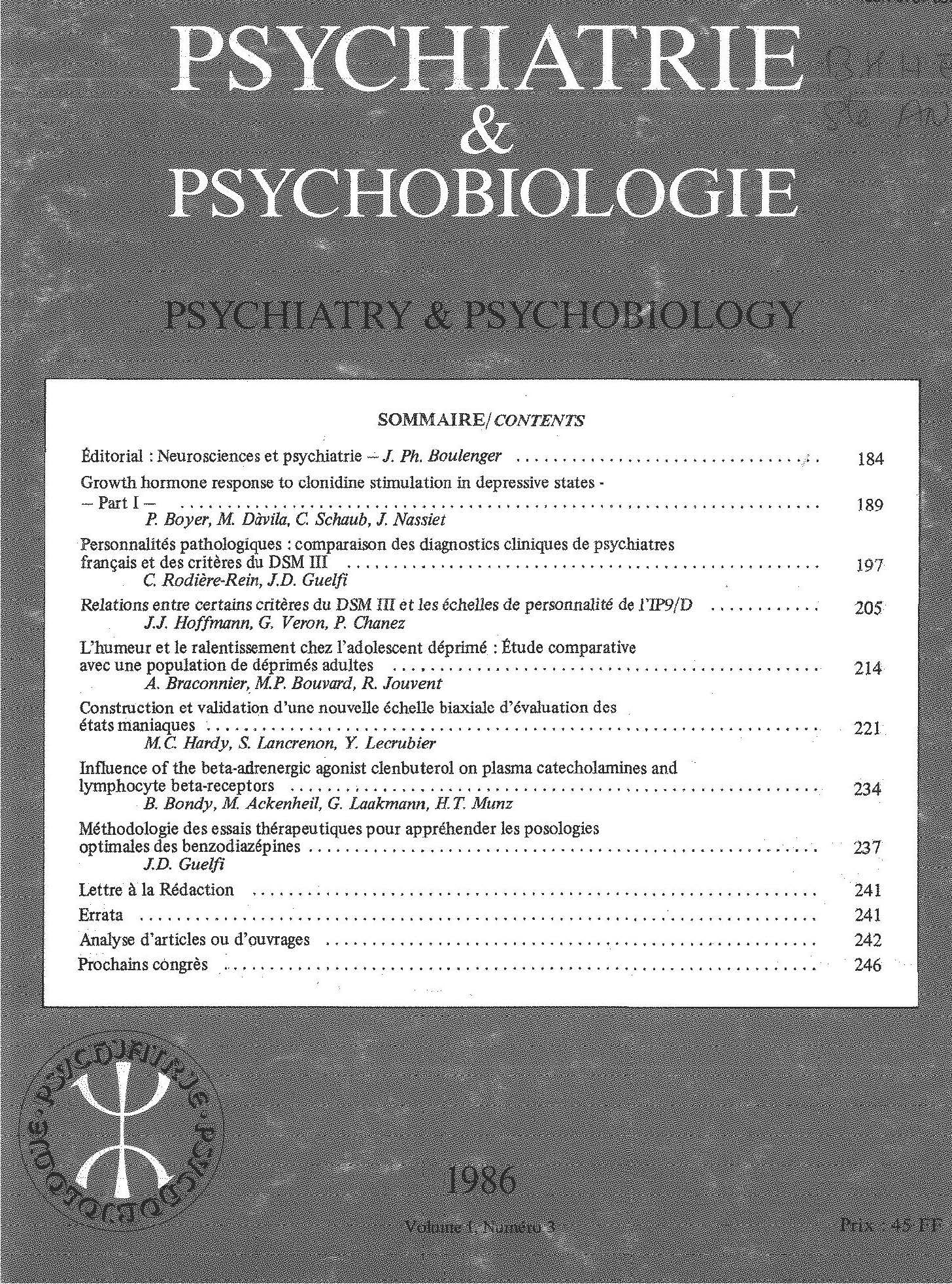Article contents
Epidémiologie de la dépression: données récentes. II — Epidémiologie analytique et épidémiologie d’évaluation
Published online by Cambridge University Press: 28 April 2020
Résumé
Les données provenant d’études récentes concernant l’épidémiologie analytique et l’épidémiologie d’évauation de la dépression sont examinées.
Au sujet de l’épidémiologie analytique, il peut être conclu de la littérature actuellement disponible que les principaux facteurs de risques pour la dépression majeure sont : a) Sociodémographiques, à savoir : être une femme, être jeune, séparé, divorcé, ou avoir des problèmes conjugaux (les auteurs soulignent en particulier que les différences entre les sexes, concernant la dépression, sont réelles et ne sont pas un artefact lié à la façon de relater les troubles ou au comportement vis-à-vis des soins), b) Environnementaux: facteurs prédisposants (les événements de vie qui surviennent durant l'enfance peuvent prédisposer un individu à la dépression à l’âge adulte) et facteurs précipitants (il y a relation entre la survenue d’événements de vie pendant la vie adulte et le début de la dépression), c) Familiaux: il y a une multiblication par 2 à 5 du taux de dépression majeure chez les parents de premier degré de sujets témoins par rapport à es témoins non malades. L’influence de l’hérédité génétique est supportée par des études de jumeaux et des études adoption, mais une large part de la variance ne peut être expliquée, d) Divers: qui concernent le cycle de reproduc- 10n de la femme (la période du post partum entraîne une augmentation du taux de dépression) et les variations saisonneres (pics au printemps et en automne).
En ce qui concerne l'épidémiologie d’évaluation, il est habituel de distinguer prévention primaire, secondaire et teriaie. Leur dessein est respectivement de diminuer l’incidence de la dépression, la prévalence de la dépression et les isques de chronicité et de la récurrence. Les efforts concernant la prévention primaire ne peuvent avoir qu’un effet imité. Dans le domaine de la prévention secondaire, il peut être conclu que beaucoup de dépressifs ne sont pas diaglostiqués ou ne sont pas traités. La prévention tertiaire a pour dessein de limiter deux risques: la chronicité et la récurence. Le premier pourrait être évalué à 15-20% à chaque épisode. Les facteurs de risques principaux seraient la présence un trouble psychiatrique non affectif ou d’une affection physique, une personnalité névrotique et un faible niveau le traitement. Pour le risque de récurrence, on peut considérer qu’entre 50 et 85% des patients ayant fait un épisode lépressif majeur feront au moins un autre épisode de dépression ultérieurement. Les facteurs de risques pourraient re un Stand nombre d’épisodes antérieurs, un antécédent d’épisode maniaque ou d’hypomanie, l’association à un ésordre psychiatrique non affectif ou à une affection physique, une histoire familiale de maladie affective ou un âge e début tardif.
Summary
It can be concluded from currently available literature in analytic epidemiology that the main risk factors for depression are: a) Sociodemographical, that is to say: being female, young, divorced or having marital discord (the authors insist on the fact that sex differences in depression are real and not an artifact of reporting or health care behavior), b) Environmental: predisposing factors (events occurring in childhood may predispose a person to depression in adulthood) and precipitating factors (there is a relationship between events in adult life and the onset of depression), c) Familial: there is a 2 to 5-fold increase in major depression in first degree relatives of probands suffering from depression as compared to relatives of non ill control subjects. The influence of genetic heredity is supported by studies of twins and adoption cases, but a large part of the variance is not accounted for. d) Miscellaneous: those which concern the female reproductive system (the post partum period induces an increase in depression) and seasonal variations (peaks in spring and autumn).
Regarding epidemiology evaluation, it is customary to distinguish between primary, secondary and tertiary prevention. Their aim is respectively to diminish depression incidence, prevalence and the risk of chronicity and relapse. Efforts at primary prevention can have only limited effectiveness. In the field of secondary prevention, it can be concluded that many people suffering from depression are undiagnosed and untreated. Tertiary prevention aims at limiting two risks: chronicity and recurrence. Following a given period of depression, chronicity can be estimated at from 15-20%. Risk factors may be: presence of a non affective psychiatric disorder or a physical illness, a neurotic personality and a low level of treatment. As for the risk of recurrence, 50-85% of patients suffering from major depression will have at least one subsequent episode later in life. Risk factors may be: a great number of previous episodes, a manic or hypomanic previous episode, the presence of a non affective psychiatric disorder or a physical illness, a family history of affective illness and an older age at onset.
Keywords
- Type
- Revue
- Information
- Copyright
- Copyright © European Psychiatric Association 1988
References
Références
- 1
- Cited by



Comments
No Comments have been published for this article.